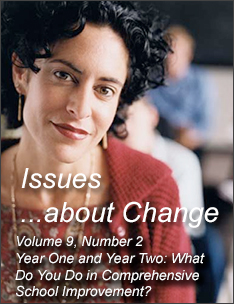Contextual Influences
Year 1.
Each of the five partner schools operated within a different community and district context. At Community and Banner High Schools, contextual issues were minimal, and easily addressed through assuring clear communication between all stakeholders. This was a central tenet of the focus of improvement efforts, although some attention was required at Banner because of the school's reaction to the community and city politics that were at play.
Contextual issues were most significant at Tall Pines, where new state and district policies and mandated curricular changes created new roles, relationships, and responsibilities among administrators, teachers, parents, and students. In addition, Tall Pines operated under a long-standing desegregation order that required careful scrutiny of any changes that might affect the racial composition of the school. A strong teachers union actively monitored the effect of these changes and FIRST improvement efforts on teachers' work and responsibilities. At Tall Pines, SEDL sought to connect all these factors to develop a coherent improvement effort.
Similarly, tensions between the district and school at Pelican High School were addressed in the first year by providing opportunities for representatives of each organization to meet, dialogue, and problem-solve. The establishment of regular meetings had a powerful and immediate impact on communication and trust between school and district personnel.
The students at San Fernando School provided this school its most challenging contextual issue. While most of the core staff at San Fernando were Euro-American, the majority of instructional assistants and students were Native American and Hispanic. SEDL staff worked to assure that the voices of instructional assistants were included and honored at staff meetings, and brought in research-based materials on connecting school curricula to students' ethnic and cultural backgrounds.
Year 2.
SEDL facilitators continued to assist school personnel in identifying and responding to a variety of contextual influences. Perhaps more critically, SEDL facilitators sought to maintain school focus on improvement goals and specific activities toward those goals, in order to prevent contextual influences from becoming excuses for stasis. SEDL helped school personnel learn to define their real spheres of influence and to "handle" issues of context. They also provided technical support in the completion of campus improvement plans, offered advice on utilization of Title I funds, and guided professional development in areas of multiculturalism and age-appropriate teaching strategies.
Reflection.
While schools are the location of improvement work, they are critically affected for better or worse by the context in which they exist. External change facilitators must have a wide and deep range of strategies and information in order to be ready to anticipate and address issues of context during improvement efforts. Bringing all parties to the table, where possible, is the best first strategy in addressing contextual issues. In all cases, more and better communication, and more and better understanding mitigated the negative aspects of context, and allowed stakeholders to begin to imagine context as a strength of, and not a hindrance to, their school.
Next Page: Leadership

